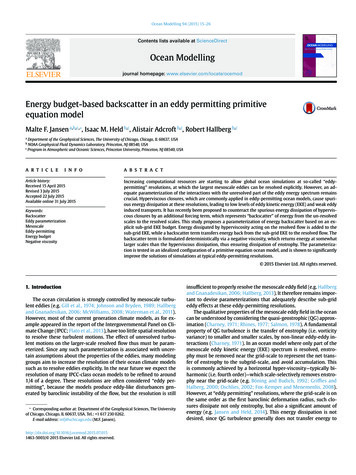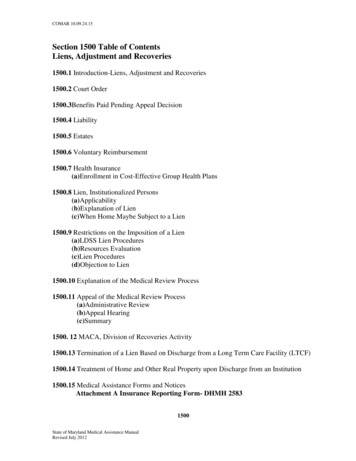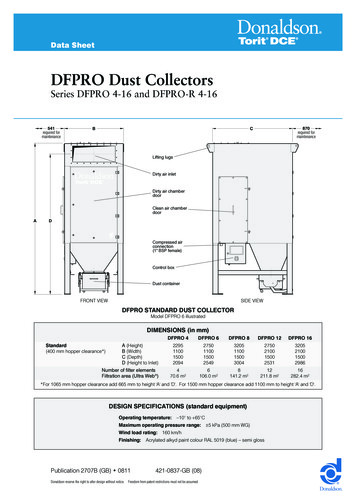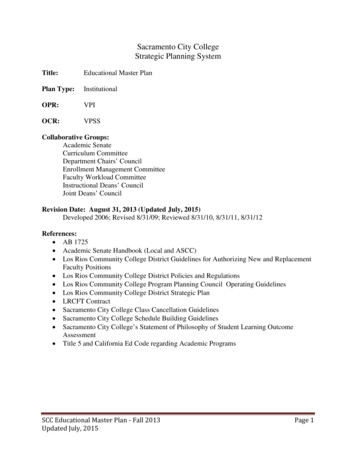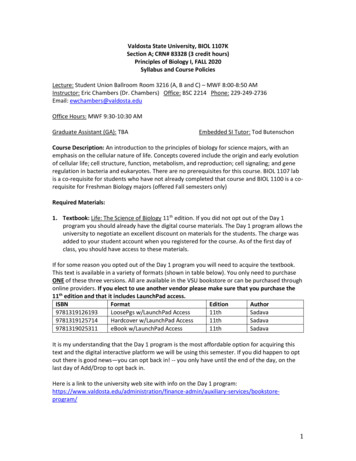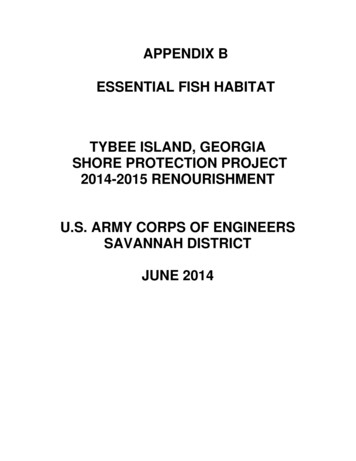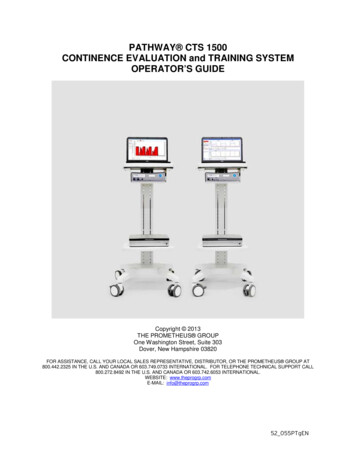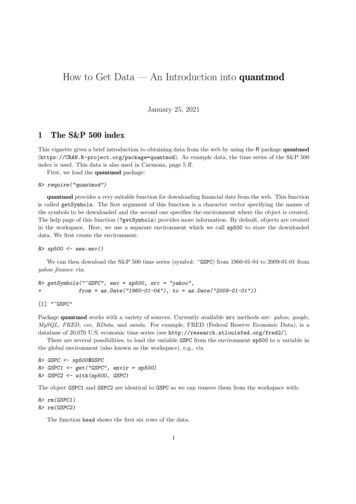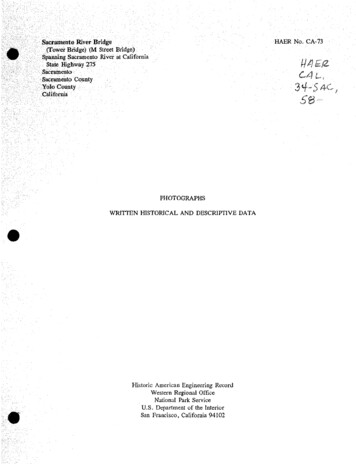
Transcription
ALEX PADILLA SECRETARY OF STATE STATE OF CALIFORNIAOFFICE OF VOTING SYSTEMS TECHNOLOGY ASSESSMENT1500 11th Street Sacramento, CA 95814 Tel 916.695-1680 Fax 916.653.4620 www.sos.ca.govDOMINION VOTING SYSTEMSDEMOCRACY SUITE 5.10ASystem ComponentsElection Management System: Software version 5.10.50.83ImageCast Evolution: Software version 5.10.10.3ImageCast Central: Software version 5.10.2.0001ImageCast X: Software version 5.10.12.4Adjudication: Software version 5.10.50.10ImageCast Precinct 2: Software version 5.10.5.1Mobile Ballot Production: Software version 5.10.50.83ImageCast Voter Activation: Software version 5.10.50.83Staff ReportPrepared by:Secretary of State’s Office ofVoting Systems Technology AssessmentJuly 9, 2020
Table of ContentsI. INTRODUCTION .31. Scope .32. Summary of the Application .3II. SUMMARY OF THE SYSTEM .41. Election Management System v. 5.10.10.1 .42. ImageCast Evolution v. 5.10.10.3.53. ImageCast X v. 5.10.12.4 .64. ImageCast Central v. 5.10.2.0001 .65. Adjudication Client v. 5.10.50.12 .66. ImageCast Precinct 2 v. 5.10.5.1 .77. Mobile Ballot Production v. 5.10.50.83 .78. ImageCast Voter Activation v. 5.10.50.83 .7III. TESTING INFORMATION AND RESULTS .81. Background .82. Functional Testing Summary .93. Additional Functional Testing .134. Functional Testing Results .145. Software Review Testing Summary and Findings .14IV. CONCLUSION .142 PageSECRETARY OF STATE’S STAFF REPORT- DOMINION DEMOCRACY SUITE 5.10A VOTING SYSTEM
I. INTRODUCTION1. ScopeThe purpose of this report is to present the test results for the updated version of theDominion Voting Systems Democracy Suite (DS) 5.10 voting system, now referred to asDS5.10A. The purpose of testing is to verify functionality of performance enhancements,bug fixes, additional languages added to the system to comply with California ElectionsCode section 14201 language requirements, and added jurisdictional specific reports.Support for the following languages was added to the system: Indonesian, Laotian,Mien, Urdu, Bengali, Burmese, Gujarati, Hindi, Thai, Mongolian, Nepali, Tamil, andTelegu. A new California report export package was added to the system whichincludes corrections to various calculations in the District Canvas and ElectionSummary reports, changes to the Election Night Export report to include the precinctreporting flag, and changes to California auto-reporting templates.Testing also uncovers other findings, which do not constitute non-compliance, andthose findings are reported to the voting system vendor to address the issuesprocedurally. The procedures for mitigating any additional findings are made to thedocumentation, specifically the California Use Procedures.2. Summary of the ApplicationDominion submitted an application for the DS 5.10A voting system, which is comprisedof the following major components: Election Management System: Software version 5.10.50.83ImageCast Evolution: Software version 5.10.10.3ImageCast Central: Software version 5.10.2.0001ImageCast X: Software version 5.10.12.4Adjudication: Software version 5.10.50.10ImageCast Precinct 2: Software version 5.10.5.1Mobile Ballot Production: Software version 5.10.50.83ImageCast Voter Activation: Software version 5.10.50.83Canon G1130 V1 1.33Canon G1130 V2 2.02Canon G2140 1.23ImageCast HiPro 1.2.2.1Oki C712 PrinterOki M402dne PrinterTesting was accomplished utilizing the DS5.10 voting system hardware already at theCalifornia Secretary of State’s office. The DS5.10A testing was accomplished using theexact same hardware that was certified for DS5.10, except the IntraScan scanner thatwas replaced at the start of testing. Pro V&V, a Federally Certified Voting Systems Test3 PageSECRETARY OF STATE’S STAFF REPORT- DOMINION DEMOCRACY SUITE 5.10A VOTING SYSTEM
Laboratory reviewed the source code, and then supplied the trusted build of theDS5.10A voting system. Dominion was also required to provide the California UseProcedures for the DS5.10A system.II. SUMMARY OF THE SYSTEMThe DS 5.10A computers represented in this system are all operating on MicrosoftWindows 10 systems that were patched current at the time the trusted build wascreated by Pro V&V for the functional testing. Currently, Microsoft is schedulingExtended Support for Windows 10 until October 14, 2025. Microsoft is currentlyscheduling Extended Support for Server 2016 until January 1, 2027.The network protocol used in the DS5.10A is Transmission Control Protocol/InternetProtocol (TCP/IP) using Dynamic Host Configuration Protocol (DHCP) foraddressing. The DHCP service runs on both Election Event Designer (EED) andResults Tally Reporting (RTR) servers. Domain Name Service (DNS) is used foraddress resolution and runs on both servers. Unused ports are closed on all machines,and services that are not needed are disabled. The system is setup in a client serverconfiguration, with all election data stored on the servers. This facilitates backups, andthe server drives are encrypted. The Election Management System (EMS) and RTRservers utilize Dell Self Encrypting Drive (SED) Technology. These drives areprovisioned with a key at installation time, and the EMS database files are stored underthe encrypted disk drives. The encryption platform utilizes a National Institute ofStandards and Technology (NIST) certified hardware-based cryptographic engine whichprovides real-time encryption and decryption of data using AES-256 algorithms. Inaddition, the encrypted storage platforms provide the access control through usingiButton security keys.The default storage configuration on the servers is two drives in a RAID 1 (DiskMirroring) configuration for the operating system, and four drives in a RAID 10 (mirroringand striping) configuration for data storage.The system does not include modems, or telecommunications devices, and there is noprovision for accessing external networks. No failover/redundant configuration wastested, however, the servers each run both EED and RTR providing redundancy.The Democracy Suite 5.10A voting system consists of eight major components.1. Election Management System (EMS), v. 5.10.50.83EMS is a set of the following applications that are responsible for pre-voting and postvoting activities, including ballot layout, generation of audio files, programming media forvoting equipment, importing results data, and accumulating and reporting results.a) EMS-Election Data Translator (EDT), v. 5.10.50.834 PageSECRETARY OF STATE’S STAFF REPORT- DOMINION DEMOCRACY SUITE 5.10A VOTING SYSTEM
EDT is an application that imports and exports election data, such as districts,precincts, contests, candidates, translations, etc., to and from the election project(a.k.a. election definition).b) EMS-Election Event Designer (EED), v. 5.10.50.83EED is an application that handles most of the pre-voting activities. EED is theapplication that receives the imported data from EDT and Audio Studio togenerate ballot structure, ballot artwork, and tabulator files, including all the audiofor an accessible voting session on the precinct tabulators.c) EMS-Audio Studio, v. 5.10.50.83Audio Studio is an application that assists jurisdictions with the creation of audiofiles. It can be used to verify, listen, and record audio files in EED.d) EMS-Results Tally Reporting (RTR), v. 5.10.50.83RTR is the main application for post-voting activities. It receives election resultsfrom the tabulators, allows for validation of the results, and reports the results.RTR can be used for the addition, and deletion of tabulator files. It also allows formanual resolution of qualified write-ins.e) EMS-File System Service, v. 5.10.50.83File System Service is a stand-alone service running on client machines enablingaccess to low level operating system application programming interface (API) forportioning compact flash (CF) cards.f) EMS-Data Center Manager, v. 5.10.50.83Data Center Manager is a system-level configuration application used in EMSback-end data center configuration.g) EMS-Application Server, v. 5.10.50.85Application Server is a server-side application responsible for executing longrunning processes, such as rendering ballots, generating audio files and electionfiles.h) EMS-Adjudication Service, v. 5.10.50.10EMS-Adjudication Service is a software service that provides EMS data to theAdjudication Services application.i) EMS-Smart Card Helper Service v. 5.10.11.24EMS-Smart Card Helper Service is a software service that provides theconnection to the smart card reader to allow you to program technician, pollworker, and voter cards.j) EMS-ImageCast Voter Activation v. 5.10.50.83EMS-ImageCast Voter Activation is a software service that allows you to activatevoter cards.5 PageSECRETARY OF STATE’S STAFF REPORT- DOMINION DEMOCRACY SUITE 5.10A VOTING SYSTEM
2. ImageCast Evolution (ICE), v. 5.10.10.3ICE is an all-in-one precinct optical scan tabulator and ballot marking device. The ICEcan accept pre-marked ballots, give voters a second-chance notification on ballot errors,and provide a final ballot review based on the machine’s interpretation of the handmarked ballot. The software prevents the scanning and tabulating of a vote with amarginal mark based on thresholds set in EED. The ballot marking capabilities allow avoter to place a blank ballot into the machine and vote using the accessible tactileinterface (ATI), sip-n-puff, or paddle switches. When the ballot marking capabilities areturned on the voter also has the capability to use the audio features. The versionsubmitted for California has the audio capability to handle any of the ten languagesrequired by the U.S. Department of Justice (English, Spanish, Chinese, Japanese,Tagalog, Korean, Vietnamese, Thai, Hindi, and Khmer).3. ImageCast X (ICX), v. 5.10.12.4The ICX was tested in two versions: The Avalue-21 Classic and the Avalue 21 Prime.ICX is an accessible ballot marking device. The ballot marking capabilities allow a voterto vote using the accessible tactile interface (ATI), sip-n-puff, or paddle switches. Theversion submitted for California has the audio capability to handle any of the tenlanguages required by the U.S. Department of Justice (English, Spanish, Chinese,Japanese, Tagalog, Korean, Vietnamese, Thai, Hindi, and Khmer). The ICX requiresthe voter to insert an activation card which is generated by a poll worker. The activationcard can be created with accessible options enabled so that the voter is presented withall the accessible options when the voting session is initiated.4. ImageCast Central (ICC), v. 5.10.2.0001ICC uses commercial-off-the-shelf (COTS) Canon DR-X10C, Canon DR-G1130, CanonDR-G2140, and Interscan HiPro scanners at the central tabulation location to scan voteby mail ballots and post-voting ballots, such as provisional ballots, vote by mail ballotsnot delivered until Election Day, ballots that need to be duplicated, and ballots that werescanned into a multi-precinct ICE tabulator. The results from batches scanned throughthe ICC are dropped into a folder on the server for the Adjudication Client to access.5. Adjudication Client, v. 5.10.50.12Adjudication Client is an application that allows the jurisdiction to resolve a ballot onscreen that would normally be out stacked to be remade or hand counted because ithad one or more exception conditions, such as write-ins, over-votes, marginal marks,under-votes, or because it is a completely blank ballot. The Adjudication Client has tworoles, Administration and Ballot Inspection. The functionality of the Administration role isto configure user accounts, exception reasons (e.g. write-ins and over-votes), batchmanagement, and report generation. In the California configuration, the Administrationrole must be performed directly on the server. Ballot Inspection allows users to reviewballots that have at least one exception condition as defined by the Administration role.The user may accept the ballot as is or resolve the ballot pursuant to California law.6 PageSECRETARY OF STATE’S STAFF REPORT- DOMINION DEMOCRACY SUITE 5.10A VOTING SYSTEM
Each ballot that is adjudicated is stamped with the username of the user who made thechange.6. ImageCast Precinct 2, v. 5.10.5.1The ImageCast Precinct 2 (ICP2) device is a precinct-level, optical scan ballot counterdesigned to provide two major functionalities: ballot scanning and tabulation, and ballotreview and second chance voting. The ballot review feature allows voters to review theirselections and change any votes by remarking the ballot. Once a paper ballot isprocessed, the voting results for a given ballot are displayed on the monitor forverification. The results are presented in text format, which allows voters to identify anyvoting errors they may have made and to verify that the tabulator has correctly identifiedthe selections.7. Mobile Ballot Production, v. 5.10.50.83The Mobile Ballot Production (MBP) 5.10A.11.24 system is an on-demand ballot printingsystem consisting of a Dell Latitude 3490 laptop, OKI C712, and OKI C931 printers.The MBP 5.10A.11.24 system operates in conjunction with the Democracy Suite 5.10Avoting system. The DS 5.10A EMS creates MBP ready ballot images in .PDF formatcomplete with tint and watermark. These ballot images are exported to the MBP laptop,and then printed on blank paper. To identify the correct ballot style, the MBP systemcan sort by precinct, ballot group, and several other data points. Once setup andconfiguration are complete, the MBP laptop only contains geopolitical information, anddoes not contain any voter information. The MBP system will generate many differentreports, including total number of ballots printed, and number of each ballot styleprinted. The reports can be generated in Excel, Word, and PDF formats.8. ImageCast Voter Activation, v. 5.10.50.83The ImageCast Voter Activation (ICVA) 5.10A.11.24 application is a polling place/votecenter location tool that allows poll workers to program smart cards for voters in order toactivate voting sessions on ImageCast X. Voter Activation cards can be created ineither standard or accessible modes. The ICVA consists of the application, Dell Latitude3490 laptop and USB Smart Card reader/writer.7 PageSECRETARY OF STATE’S STAFF REPORT- DOMINION DEMOCRACY SUITE 5.10A VOTING SYSTEM
High Level Block DiagramIII. TESTING INFORMATION AND RESULTS1. BackgroundDominion submitted an application to the Secretary of State for Administrative Approvalof modifications to the DS5.10 voting system. The purpose of testing is to verifyfunctionality of bug fixes, performance enhancements, and additional languages addedto the system to comply with California Elections Code section 14201 languagerequirements and added jurisdictional specific reports. Support for the followinglanguages was added to the system: Indonesian, Laotian, Mien, Urdu, Bengali,Burmese, Gujarati, Hindi, Thai, Mongolian, Nepali, Tamil, and Telegu. A new Californiareport export package was added to the system which includes corrections to variouscalculations in the District Canvas and Election Summary reports, changes to theElection Night Export report to include the precinct reporting flag, and changes toCalifornia auto-reporting templates. The updated voting system was named DemocracySuite 5.10A.8 PageSECRETARY OF STATE’S STAFF REPORT- DOMINION DEMOCRACY SUITE 5.10A VOTING SYSTEM
The testing began with the creation of the trusted build by Pro V&V, a federally certifiedVoting System Test Laboratory. Pro V&V also performed a source code review of theDS 5.10A voting system in June 2020. Please refer to the Source Code Review Reportfrom Pro V&V.Functional testing of the Dominion DS 5.10A voting system was conducted by Office ofVoting Systems Technology Assessment (OVSTA) staff at the Secretary of State’sOffice located at 1500 11th Street, Sacramento, California from June 4, 2020, throughJune 23, 2020.The test lab was configured in a real-world environment simulating an actual votingsystem in use by a California County. The Vote Center/Polling Place was setup with theVoter Activation Card Laptop, ICX machines, ICE machine, and Mobile BallotProduction for on demand printing. EED and RTR were setup as per the logical mapbelow. Strict adherence to the air-gap architecture was maintained throughout testing.Media of any kind was only allowed to go from EED to RTR, and was then cleaned,reformatted and returned to the test.Functional Testing Configuration2. Functional Testing SummaryFunctional testing was conducted utilizing the DS5.10 voting system hardware storedwith the California Secretary of State’s office from prior certification testing, with theexception of the IntraScan Scanner, which needed to be replaced due to amalfunctioning cable.The Secretary of State ran the Functional Test as if it were a jurisdiction that justpurchased the voting system. Testing of the system began by setting up all equipmentin a configuration that mirrored a production voting system. The DS5.10A architecture9 PageSECRETARY OF STATE’S STAFF REPORT- DOMINION DEMOCRACY SUITE 5.10A VOTING SYSTEM
allows elections officials to use one or more, permanent server(s) and set of centraloffice voting devices, known to be running unaltered, certified software and firmware tocreate memory cards before each election and to use another, physically separate“sacrificial” server and set of voting devices after the election to tabulate results andgenerate reports. To transfer election specific data, the ICP2 machines utilize SD cards,the ICC and ICE machines utilize CF cards, and the ICX utilizes USB sticks. Theelection specific data (files) transferred on these cards are encrypted. An iButton isrequired to unencrypt the SD and CF cards for the ICP2, ICC, and ICE, and a smartcardis needed to unencrypt the USB sticks used to transfer data to the ICX machines. Thekey used for these devices can be unified or not. A unified key is one that is electionspecific. A key specific to that iButton (polling place specific) can be used also. Thiswould prevent a malicious actor from accessing the entire system with just one key.The hardware consisted of two Dell PowerEdge R640 servers (EMS & RTR Server),two Dell Tower 3430 (Clients), three Dell OptiPlex 3050 All in Ones (ICCs) with touchscreen, Dell 7060 (ICC High Speed Scanner), and two Dell Latitude 3490 laptops (VoterActivation Card & EED Cleaner). Testing began with the installation of the voting systemtrusted build software, and then continued through the security hardening process. Thenthe firmware was installed on the ICX, ICE, and ICP2 machines.The trusted build included Windows Defender on all EED and RTR systems Windowsbased computers. The ICX voting machines running Android do not have anti-virusinstalled. The ICE and ICP2 machines run firmware without an operating system.After the trusted build installations, HASHes of the “Trusted Build” installations weregenerated to accomplish validations of the installations at a later date.Functional Testing of the system included a Logic and Accuracy (L&A) test electionusing ballots from the General Test Election, and three main election types: aPresidential Primary, a Presidential General, and a Special Recall. The test deck ballotswere created using the following general rules: Per California Elections Code (EC) 13002, ballots areprinted with a watermark and tint from the approved list forCalifornia;Pursuant to the requirements of EC 13203, ballots areclearly labeled as TEST BALLOTS instead of OFFICIALBALLOTS;Ballots contain Instructions to Voters per EC 13204 and13205, but may also include instructions at the bottom of theballot per EC 13231;Candidates are listed per EC 13103;Candidate’s political party are listed per EC 13105;Per EC 13107, each candidate is to have an occupationlisted under the candidate's name. For economy of testing,the following 'occupation' was used for all candidates:Occupation Prints Here - la ocupacion demuestra aqui.10 P a g eSECRETARY OF STATE’S STAFF REPORT- DOMINION DEMOCRACY SUITE 5.10A VOTING SYSTEM
The test elections were conducted with the primary goal of exercising the newlanguages to make sure that all components were capable of these languages. Preprinted ballots were supplied by Dominion. Polls were opened and voting at theprecincts/vote centers simulating both early voting for a vote center, and election dayvoting were accomplished using the ICE, ICP2, and ICX. Ballots were scanned on allICCs simulating mail-in ballots. At the close of polls, the memory cards from the ICEvoting machine and the ICX voting machines were brought into RTR. Ballots scannedon the ICCs were aggregated to RTR. Ballots containing an exception condition wereresolved using adjudication. Next, results were tabulated, validated against theexpected results, and published. The Official Canvass Summary report and Statementof Votes Cast reports were generated. Additionally, the Secretary of State SupplementalStatement of Votes (SSOV) report was generated. All test elections were evaluated forairgap compliance, with a “cleaner” laptop used to wipe, reformat, and scan all mediafor malware prior to being re-introduced into the EED environment again.Ballots from the General Election were utilized to complete an L&A test election toevaluate the system. Ten ballots were removed from the test deck. In addition, 5 ballotsin each language were printed on the MBP, and 5 ballots in each language weremarked and printed on each ICX Prime and ICX Classic, utilizing standard voteractivation cards. An expected results spreadsheet was created, and the ballots werescanned in equal numbers on the ICP2, G1130 and G2140 scanners.Polls were closed, all results were merged into RTR, and all reports were generated andsaved.At this time, it was noted that the IntraScan scanner was displaying a 911 error. Inaddition, the IntraScan scanner displayed a 912 error. A patch cable and the motioncontrol boards were replaced without success. After further troubleshooting, theIntraScan scanner was replaced. Dominion did a root cause analysis, and this was laterdetermined to be a zip tie that wore through a harness cable resulting from normalwear. In addition, the firmware for the ICE was missing the Burmese font. The firmwareincluding the Burmese font for the ICE was regenerated by Pro V&V, and the ICE wasreimaged with the updated firmware.At the start of the L&A test election, it was noted that the ICE was unable to print aballot. The ink cartridge was replaced, and the ICE functioned as normal. It isrecommended that the ink cartridge be replaced after any amount of storage time forthe ICE.The General Election was conducted after the L&A, simulating a county that has donean L&A, and then moves the machines to the polling places and conducts the actualelection.Presidential General Election: The Presidential General Election was tested inEnglish, Indonesian, Laotian, Mien, and Urdu. One bilingual ballot style was includedconsisting of English and Urdu. The election included two ballot measures. The ICX,ICP2, and ICCs were programmed to support the entire election in all five languages.The election included ten precincts, 18 contests, and 45 options, with two write-ins. The11 P a g eSECRETARY OF STATE’S STAFF REPORT- DOMINION DEMOCRACY SUITE 5.10A VOTING SYSTEM
candidates were rotated per EC 13111. The order of offices on the ballot were per EC13109. Per EC 13105, each partisan candidate had the party affiliation listed to the rightof their name. This election was printed on twelve-inch ballots which are the smallestballot size possible and included two cards. Adjudication was set to filter blank ballots,ambiguous marks, overvotes, and write-ins.Polls were opened and zero tapes were printed. It was verified that the ICX utilizes alocalization file to present each language correctly on the navigation tabs, informationscreens, and options on the voter interface. The file is named language localizations .json. The pre-printed test deck was scanned though eachICC. The MBP was utilized to print 5 ballots in each language. The twenty-five ballotsprinted on the MBP were scanned on the ICP2 and ICE. Five ballots in each languagewere marked and printed on the ICX Prime, and 5 ballots of each language weremarked and printed on the ICX Classic. All ICX printed ballots were then scanned onthe ICE, and then on the ICP2. All ballots printed on the MBP, as well as all ballotsprinted on both ICXs were then scanned through all ICCs.A voter activation card was created for accessible sessions and used to exercise eachlanguage on the ICE and both ICXs. The ATI, headphones, text size, contrast, securityscreen, and language options worked as expected. Ballots appeared to print in thecorrect language. Ballots were fed in all orientations and the scanners performed asexpected. Ballots were then scanned on the ICCs and results were as expected.All ballots were adjudicated, aggregated in RTR, and tabulated. The results wereevaluated, and the expected results did not match the actual count. A pattern of errorwas identified, and this led to the error being attributed to the 10 ballots which wereused for the L&A. These ballots had not been returned to the general test deck. Afterthey were added back, the results matched the expected results.Polls were closed in accordance with California Use Procedures. At this time, it wasnoted that the ballot counter on the ICP2 display reads ballots but displays the numberof cards. Results were generated from ICP2 and ICE, and results media were used totransfer results back to RTR. Post-Election results were consolidated from the ICCs.Results included generation of all reports and verifying canvass – Summary, Statementof Vote (SOV), Supplementary Statement of Vote (SSOV), over-votes, and under-votes.Backups were taken as if the files would be supplied to the California Secretary of Stateto meet the “Vote Count” program requirement prior to an election.Primary Election: The Presidential Primary was tested in English, Bengali, Burmese,Gujarati, Hindi, and Thai. The election included 10 precincts and eight party splits perprecinct. It included 20 contests and 65 choices. Ballots included one bi-lingual ballotstyle consisting of English and Burmese. The ICE, ICP2, ICXs, and MBP wereprogrammed to support the entire election in all languages. Ballots were seventeen inchwhich is the medium size possible for the system, and double sided.Polls were opened and zero tapes printed. The ICX Prime and ICX Classic deviceswere utilized to mark ballots in all languages, including changing languages midway12 P a g eSECRETARY OF STATE’S STAFF REPORT- DOMINION DEMOCRACY SUITE 5.10A VOTING SYSTEM
through the ballot being voted. Text size and contrast were verified to meet expectedcriteria. The ability of the ICX to return from the review screen to alleviate any problemswas verified. The ICE was utilized to mark and cast ballots in all languages. Onecomplete pre-printed test deck was scanned on the ICE, ICP2, and ICCs and resultswere as expected. Mobile Ballot Production was used to print ten ballots in eachlanguage, and the results were as expected. The ICX and MBP printed ballots werescanned on the ICP2 as well as all ICCs and the results were as expected.Polls were closed in accordance with California Use Procedures, including printingresults from ICE and ICC, removing results media to transfer results back to EMS, andthen shutting down devices. Post-Election results were consolidated and reportedbased on the upload of results to EMS from all tabulating (ICE and ICC) units. Allreports were generated and verified including Summary, SOV, SSOV, over-votes, andunder-votes.Recall Election: The Special Recall was conducted in English, Mongolian, Nepali,Tamil, and Telegu. The election consisted of one precinct and one contest. The contestincluded 135 choices with one write-in in a gubernatorial contest. The election wasprinted on twenty-two inch ballots, which are the longest ballot size possible for thesystem. The ICX machine stores the election data in a sandboxed partition in theinternal hard drive of the machine. During the recall election, activation card functionalitywas tested. The ICVA laptop was utilized to create all three types of cards: poll worker,technician, and voter. All three types of cards were tested without incident. Bothaccessible access and regular voter cards were created and utilized throughout allelections without error.The entire pre-printed test deck was scanned though each ICC except the IntraScan.The MBP was utilized to print 5 ballots in each language. At this time, it was noted thatthe election did not contain a fully translated ballot in Bengali. The fully translatedBengali ballot was provided and testing continued. The twenty ballots printed on theMBP were scanned on the ICP2 and ICE. Five ballots in each language were
Pro V&V, a Federally Certified Voting Systems Test . 4 P a g e SECRETARY OF STATE'S STAFF REPORT- DOMINION DEMOCRACY SUITE 5.10A VOTING SYSTEM . EMS-Adjudication Service is a software service that provides EMS data to the Adjudication Services application. i) EMS-Smart Card Helper Service v. 5.10.11.24 .
